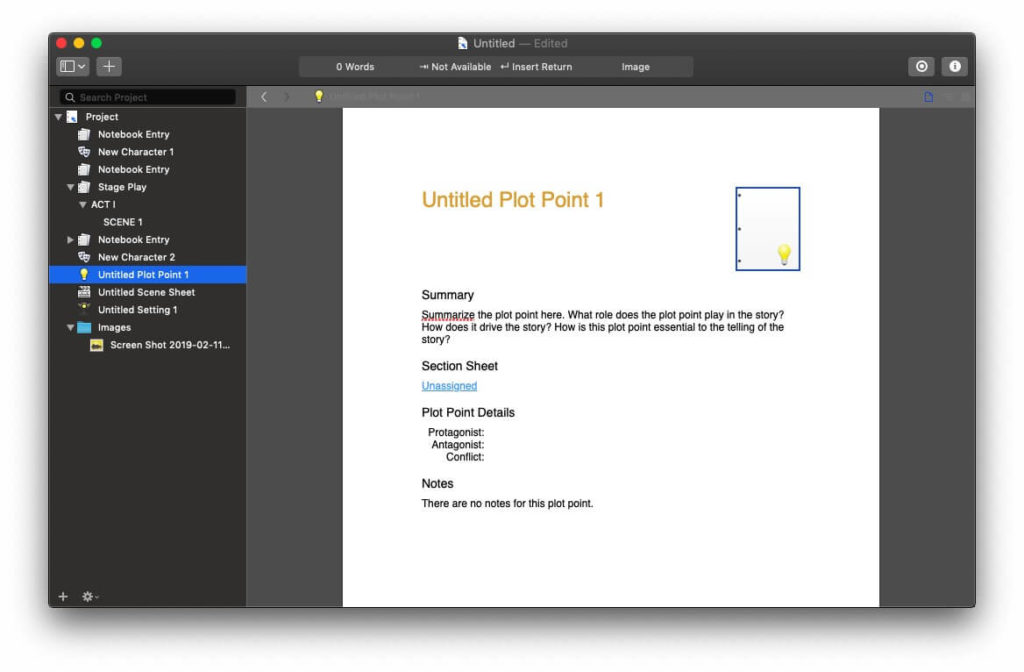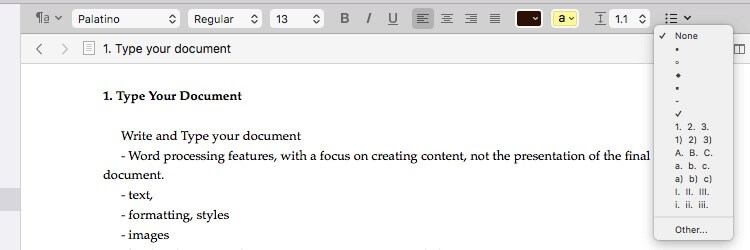
Very good to get an overview of the document, see which “sections” need work (e.g., status as First Draft, Word Count). So, in Scrivener one outline “cell” is actually a text file - it is a structure outline. Sometimes it is hard to remember during writing what a section is supposed to accomplish and this meta information (in another color and with checkboxes) is a tremendous help. If you look at the first Circus Ponies Notebook image in this posting, you see orange text as a child cell under the Method section parent cell (“show what was done …”) and likewise as a child cell under the Design parent cell (“begins with an overview …”). I strongly recommend using meta information, for example what should be in a section or what should be clear after reading a section, in the outline. And given that you can add a checkbox to each cell you can always stop and resume writing and know where you stopped.

You can also collect information in a dedicated notebook and copy and paste the cells in a new notebook, in which you put what you need for writing the article. Of course the cells can be shifted around, copied and pasted, and if done correctly (simple copy and paste) the tags stay attached to the cell. See Circus Ponies Notebook for Academic Writing (e.g., Thesis Writing) for more information. The cells tagged with Borwoske (2005) contain direct quotes (italics). (2004)” and contains some information what I wanted to use from this source. In the image above for example one cell is tagged with “Hawkey, R. Each cell can be tagged with the source information of the content of that cell.Īnd - very important for academic writing - you can tag each cell with a keyword, which can be used to stick the source information to any quote or information you want to use in your article or thesis. You can also add files, here for example and image and the Numbers document it is based on.

Great for summarizing what complex analysis say and seeing only the summary during the writing process. Very useful for a hierarchical structuring of information.Ĭircus Ponies Notebook also allows you to add images and summarize information in the parent cells (here for example the “interest for nanotechnology” cell which contains detailed information about the four groups, complete with an image of the ANOVA and the detailed statistical values). Like in Scrivener, you can fold (collapse) cells so that all subcells are hidden.

In Circus Ponies Notebook you can use one cell for one information unit (an idea, a quote, etc.). Now compare this with the outliner in Circus Ponies Notebook: Outline in Circus Ponies Notebook If you double-click on a line, you open that file: After clicking on a “cell” in the Outline View of Scrivener It’s a view on the structure of your document. It shows you more information like label, status and (not shown) even part of the content, but it is - essentially - the Binder in another format.

Let’s have a look at the outliner in Scrivener first: Scrivener Outline View (left: Binder, right: Outline View)Īs you can see, each “cell” (= line) in the outliner view of Scrivener is a “file”. It’s a good question, because there is a fundamental difference between Scrivener‘s outliner and an outliner like the outliner pages in Circus Ponies Notebook or of OmniOutliner. Scrivener has an integrated outliner – what are the advantages of outlining with Circus Ponies Notebook’s compared to outlining with Scrivener?” “you have mentioned Circus Ponies Notebook as an outliner. I got the following question from Carsten yesterday: In all affairs it’s a healthy thing now and then to hang a question mark on the things you have long taken for granted.


 0 kommentar(er)
0 kommentar(er)
